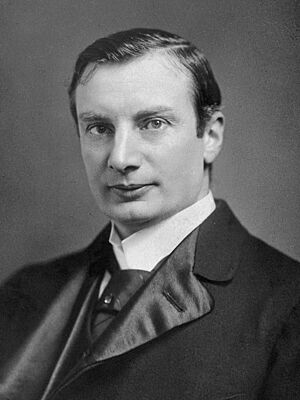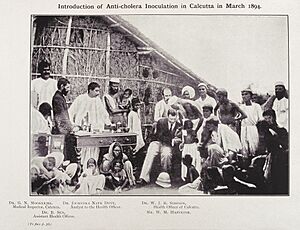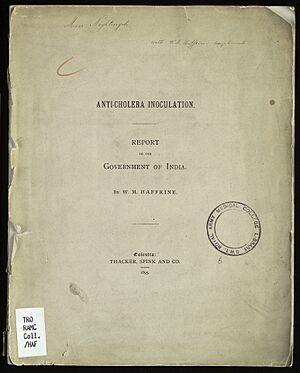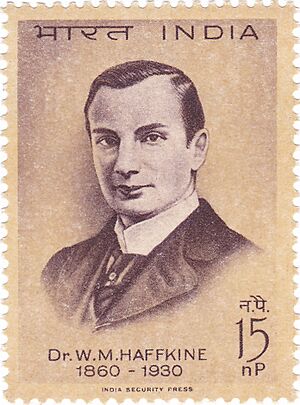Waldemar Haffkine facts for kids
Quick facts for kids
Waldemar Mordechai Haffkine
|
|
|---|---|
 |
|
| Born | 15 March 1860 |
| Died | October 26, 1930 (aged 70) |
| Citizenship | Russian Empire France (later) British |
| Alma mater | Odessa University |
| Known for | Vaccines against cholera and bubonic plague |
| Awards | Cameron Prize for Therapeutics of the University of Edinburgh (1900) |
| Scientific career | |
| Fields | Bacteriology, protozoology |
| Institutions | Odessa University, University of Geneva, Pasteur Institute, Haffkine Institute |
| Author abbrev. (botany) | Khawkine |
Waldemar Mordechai Wolff Haffkine was a brilliant scientist who created the first effective vaccines against two deadly diseases: cholera and bubonic plague. He was born in 1860 in Odessa, which is now in Ukraine. His original name was Vladimir Aronovich Khavkin.
Haffkine studied at Odessa University. Later, he moved to Switzerland and then to France. He worked at the famous Pasteur Institute in Paris. There, he developed his cholera vaccine. He even tested it on himself first to make sure it was safe! He then successfully used it in India. Many people, including the famous surgeon Joseph Lister, called him "a saviour of humanity" because of his life-saving work.
In 1897, Queen Victoria honored him for his contributions. He became a British citizen in 1900. In his later years, Haffkine became more religious. He supported Jewish causes and helped people.
Contents
Early Life and Education
Waldemar Haffkine grew up in a Jewish family in Odessa. He was the fourth of five children. He went to school in Berdyansk, Odessa, and Saint Petersburg.
When he was young, Haffkine was part of a group called the Jewish League for Self-Defense in Odessa. This group helped protect Jewish homes during attacks called pogroms. During one of these attacks, Haffkine was hurt while defending a home. He was arrested but later released thanks to the help of a biologist named Ilya Mechnikov.
Haffkine continued his studies with Mechnikov at Odessa University from 1879 to 1883. He earned his science degree at age 23. Even though he was a brilliant student, Haffkine could not become a professor in Russia because he was Jewish. So, in 1888, he moved to Switzerland. He started working at the University of Geneva. In 1889, he joined Mechnikov and Louis Pasteur at the new Pasteur Institute in Paris. He first worked there as a librarian.
Studying Tiny Organisms
Haffkine started his science career by studying very tiny living things called protozoa. He worked with Ilya Mechnikov in Odessa and later at the Pasteur Institute. His early research looked at organisms like Euglena and Paramecium. He also studied Holospora, a tiny bacterial parasite that lives inside Paramecium.
In the early 1890s, Haffkine started focusing on practical bacteriology. This is the study of bacteria. A group of tiny organisms called Khawkinea is named after Haffkine. This is because of his early studies on these organisms.
Developing the Anti-Cholera Vaccine
During Haffkine's time, a terrible disease called cholera was spreading across Asia and Europe. It was one of the biggest outbreaks of the 1800s. Scientists knew that a bacterium called Vibrio cholerae caused cholera. However, they weren't sure it was the only cause.
Haffkine focused on creating a cholera vaccine. He made a weaker version of the bacteria. This weaker version could help the body learn to fight the disease without getting sick. On July 18, 1892, Haffkine bravely tested the vaccine on himself. He then shared his findings with the Biological Society. Even though his discovery got a lot of attention in the news, many older scientists did not accept it. This included Mechnikov and Pasteur.
Haffkine believed that India was the best place to test his vaccine. Hundreds of thousands of people were dying from cholera there. With help from a British ambassador, he went to India in 1893. He set up a laboratory in Byculla in 1896. This lab later moved and became known as the Haffkine Institute.
Creating the Anti-Plague Vaccine
In October 1896, a serious outbreak of bubonic plague hit Bombay (now Mumbai). The government asked Haffkine for his help. He immediately started working on a vaccine. He set up a temporary lab in a hallway of the Grant Medical College.
After three months of hard work, Haffkine had a vaccine ready for human testing. On January 10, 1897, he tested it on himself first. Haffkine's vaccine used a small amount of the plague bacteria. This helped the body create an immune response.
After his results were announced, volunteers at the Byculla jail were given the vaccine. They survived the outbreak. Meanwhile, seven inmates who did not get the vaccine died. Haffkine's vaccine had some side effects. It also did not offer complete protection. However, it was said to reduce the risk of getting sick by up to 50 percent.
Even with Haffkine's success, some officials still preferred other methods. They focused on cleaning homes with lime and moving sick people into camps.
Haffkine's Russian colleagues, doctors V. K. Vysokovich and D. K. Zabolotny, visited him in Bombay. In 1898, a cholera outbreak happened in the Russian Empire. Haffkine's vaccine, called "Havkin's lymph," saved thousands of lives there.
By the early 1900s, four million people in India had received Haffkine's vaccine. Haffkine became the Director of the Plague Laboratory in Bombay. This lab is now called the Haffkine Institute. In 1900, he received the Cameron Prize for Therapeutics of the University of Edinburgh.
Haffkine was the first to prepare a vaccine for humans by heating the bacteria to 60°C. This killed the bacteria but kept its ability to create an immune response. One limitation of his vaccine was that it did not work against lung forms of the plague.
The Mulkowal Incident
In March 1902, a sad event happened. Nineteen villagers in Mulkowal, Punjab, died from tetanus. They had all received vaccine from the same bottle. An investigation found that this bottle had become contaminated. The way the lab sterilized things had been changed. This new method was safe and used in other places. However, the commission concluded it was the source of the problem.
Haffkine was blamed and temporarily removed from his job. This event was sometimes called the "Little Dreyfus affair." This was because it reminded people of another famous case where a Jewish person was unfairly accused. Some doctors in India were jealous of Haffkine. They were also against him because he was Jewish and Russian. There was even evidence that an assistant had dropped a bottle stopper on the ground and not cleaned it properly. This could have caused the contamination.
Later, the Lister Institute looked into the case again. They found out about the dropped stopper. In July 1907, a letter was published in The Times newspaper. It said that the case against Haffkine was "clearly disproven." Many important medical leaders signed this letter. This led to Haffkine being cleared of all blame.
Later Years and Influence
After being cleared, Haffkine's old job in Bombay was already taken. So, he moved to Calcutta and worked there until he retired in 1914. Haffkine then returned to France. Later, he moved to Lausanne, Switzerland, where he spent the rest of his life.
Historian Simon Schama has studied Haffkine's life. Schama said that Haffkine's unfair treatment was similar to the Dreyfus Affair. He noted how authorities sometimes refuse to admit their mistakes, even with clear evidence. Another writer, Paul Twivy, said: "There is no doubt that we would not have survived pandemics without Haffkine, even though he's not known. He developed vaccines against two of the biggest killers ever. He is literally the most important scientist in terms of the number of lives he saved."
Recognition and Legacy
Haffkine received many honors and awards for his work. In 1925, the Plague Laboratory in Bombay was renamed the Haffkine Institute in his honor. In the 1960s, a park was planted in Israel called Haffkine Park to celebrate 100 years since his birth.
His Religious Beliefs
In his later life, Haffkine became a very religious man. He returned to practicing Orthodox Judaism. He wrote an article called A Plea for Orthodoxy in 1916. In this article, he talked about the importance of following traditional religious practices. He also stressed how important community life is. He believed that groups of people with shared history and beliefs are strong and helpful to humanity.
In 1929, he started the Haffkine Foundation. This foundation helped support Jewish education in Eastern Europe. Haffkine also respected other religions. He thought it was very important to study the Bible.
In 1982, the Chabad Hasidic movement published letters written to Haffkine. These letters were from Rabbi Yosef Yitzchak Schneersohn. The Rabbi had asked Haffkine for help supporting Jews living in communist Russia.




